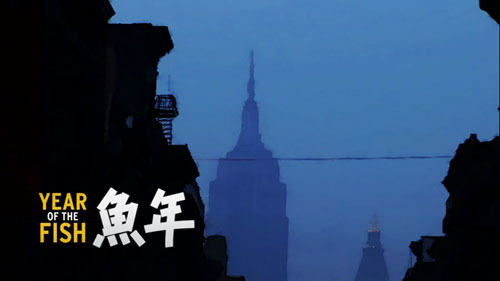
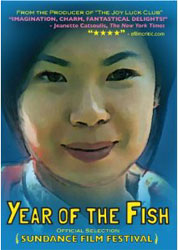 BUY FROM AMAZON: CLICK HERE!
BUY FROM AMAZON: CLICK HERE!
STUDIO: Gigantic Pictures
MSRP: $24.95
RATED: NR
RUNNING TIME: 96 minutes
SPECIAL FEATURES:
- Trailer
- Director’s and Actors’ Commentary
- Early Rotoscoping Test
- Before/After Rotoscoping Shots
The Pitch
This modern day Cinderella must find a way to avoid giving happy endings to get a happy ending!
The Humans
Tsai Chin, Ken Leung, Randall Duk Kim, and An Nguyen
The Nutshell
Writer/director David Kaplan has crafted a Chinese Cinderella story that takes place in New York Chinatown. Freshly off the boat comes Ye Xian, sent to America by her father, with hopes of a beginning new life. She is immediately forced by her Aunt and Uncle to sign a contract to pay off her debts by working in their family business. Xian is surprised to find it is not a beauty shop as she was told, but a place for local men to come for massages and “happy endings.” A chance meeting with a stranger puts into play the well-known story of Cinderella, complete with evil step-sisters, a fairy-tale ball, and fairy godmother/father.
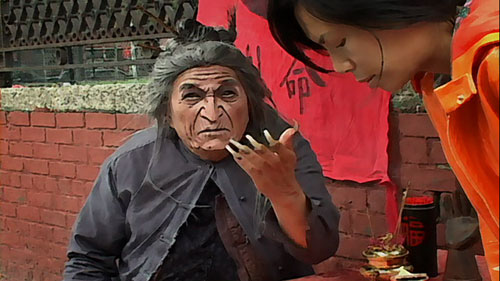
{Insert Asian Nail Salon joke here}
The Lowdown
Year of the Fish is an independent film that was an official selection at the Sundance Film Festival. It tells the common story of Cinderella, but places it in New York Chinatown, with a cast of Asian actors. This version of the Cinderella tale is based on a very old a Chinese folk tale, so this rendition of it could be considered closer to that source material than other versions which were based on early Greek stories. Unfortunately, this version is a boring, adult-themed muddle.
The first failure of Year of the Fish is the use of rotoscoping to tell the tale. Every film enthusiast knows that rotoscoping is the art of tracing over filmed footage, frame by frame, to produce a more realistic animation style. I’m sure I don’t need to tell you that, but I did anyway. The rotoscoping gives the film a muffled, pastel look which I believe was supposed to add to the fairy tale feel. What it does instead is point out the flaws in the direction, the simplicity of the camerawork, and the ugliness of the stars. The main character, Ye Xian, is supposed to be this beautiful woman that all the customers want, but the rotoscoping makes her a bland slate of face. And since the story continuously requires that she is sad or distraught, it’s very hard to like her.
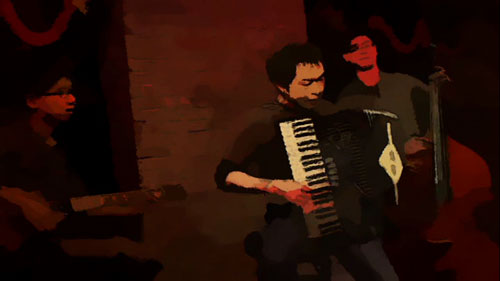
Trust me, there are no groupies for an accordion player.
When I first saw the DVD cover art, I could not tell what kind of film this was, as it was unrated. It’s obviously based on Cinderella, so is it a family tale or perhaps it’s an adult version of a classic story. (The DVD synopsis refers to a massage parlor.) Should I watch this by myself or with my family? As the great father I am, I decided to submit to it by myself to judge its acceptability. Great job! Not only did I find out it’s definitely not for kiddies, but I also saved them the anguish of watching this plodding, depressing film. There is a lot of unnecessary dialogue and content which moves this out of any type of children’s viewing and places it completely as an adult version. We’ve got dialogue concerning fingers in assholes and some uncomfortable massage scenes and dialogue. Not the kind of stuff you want your child to hear or for god’s sake your mom! Again, it’s fine if you know that it’s an adult movie from the start, but it’s seemed unnecessarily mature.
Another fault of Year of the Fish is the one-dimensional characters. The bad guys are simple caricatures, created solely as an evil thing to exist to hinder our hero, and the good guys are dull. There’s no middle ground. At one point, our star is menaced by a couple of thugs on the street in broad daylight, which then turns into about 10 guys, and they surround and torment her. In a bout of luck, she runs into her “prince” and he is able to scare away the attackers. To write these buffoons as complete white-boy gang bangers, spewing Asian epithets and threatening her with what amounts to a gang rape in broad daylight burned what little approval I had left in the film. Again, score one for me in not letting my kids watch.
Highlights of Year of this Fish include a couple of moments where the rotoscoping is used to good effect. One is when Xian finds her way to the secret location to meet her fairy godfather, and comes across three guardians. The use of shadows and camerawork in this scene were done very well. Also, you may recognize some of the actors in this film, but Ken Leung is the standout. Playing the part of the “prince”, he does the best he can with the roll he’s given. Maybe it’s because he’s built up such good will in LOST and Keeping the Faith that it was easier to like him, but I’m probably fooling myself. It’s a film like this that an actor carries with him his charm from previous works, and it’s not the character you like, but the actor.
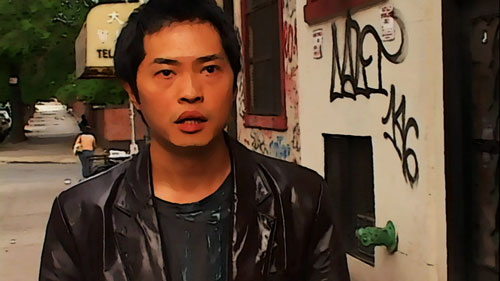
Am I remembering correctly: wasn't this the same look Ken used in every scene as Miles in LOST?
Overall, there was hardly a minute in this film that I wished I was doing something else, like watching a different film, playing a video-game, or rearranging my sock drawer. Year of the Fish tries to put the Chinese spin on the Cinderella tale, but the familiarity with the story and the sadness and pity of the star in the first three quarters of the film make it hard to muster any happiness once the end comes.
The Package
Year of the fish has the requisite commentary, with the director and two of the actresses, including Tsai Chin. It’s a fairly boring commentary that talks about the basics of the making of this film. The director continually tries to sell his use of rotoscoping by comparing the original usage of the form with the current. It’s a tool that has been around since the beginning of animation, used by Max Fleischer, Walt Disney, and Ralph Bakshi, but the use of it there was completely different than how it has been used recently, as in Linklater’s Waking Life for example. Originally it was used to make the animation more realistic, whereas today it’s used to make film look like animation. Unfortunately for this film, it comes across as a gimmick.
Also included are some footage of early test rotoscoping and some comparisons between the original film and the finalized version. The funny thing is that they use the term rotoscoping, while in this case, I’m not sure what they did was technically rotoscoping. Originally, a projector shined the filmed image onto a screen, and the animator would trace over the actor and draw their character using the actor as a realistic reference point to follow movement and action. Year of the Fish looks like they used a computer program to translate colors from the film into pastels. It looks like a Photoshopped filter button was pressed and the film was converted to pastel. In the end, it makes me think that they were trying to hide something.
Rating: 




Out of a Possible 5 Stars
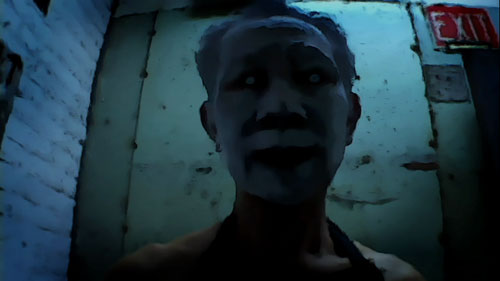
A reject from Blue Man Group: Chinatown